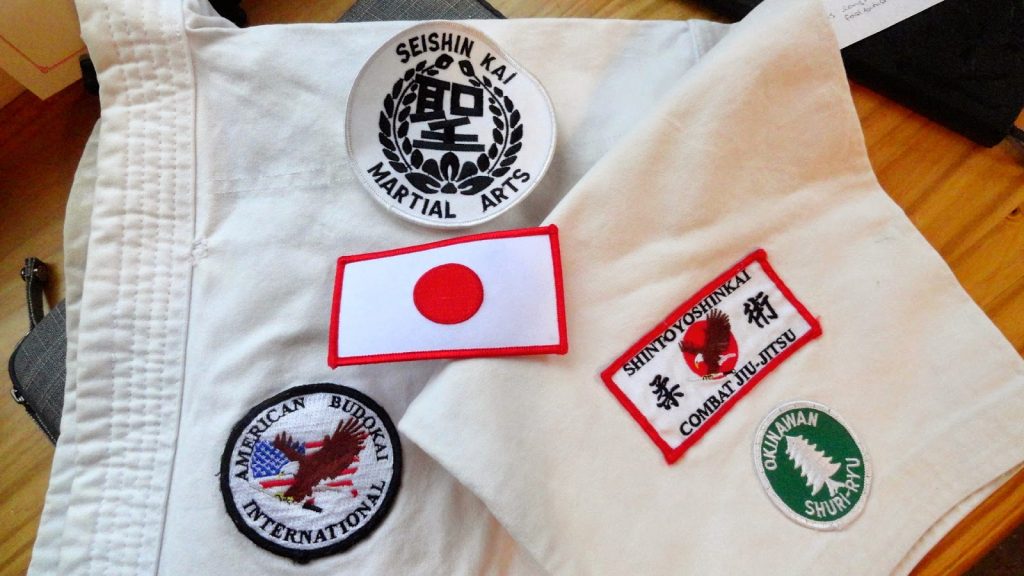Victories and Indiscretions
 |
| Changing patches, changing dojos; bittersweet and thrilling all at once! |
Re-entry into the dojo lifestyle feels like a slow and steady form of pummeling, interrupted by small victories of insight and elation. I trained for three hours Monday night and look forward to three more tomorrow night. In between, I run: 12 miles, rest. Forty-five minutes of intervals. Rest. An hour at a slow jog. Rest. I want to quit everything and become a dojo rat; just like that–it’s back in my blood.
In town for errands, I nearly hit a parked car because grow so distracted driving by the deceptive storefront–J A P A N K A R A T E–letters like a broken alphabet dangling from paint-chipped bricks. The place looks in shambles, and yet…already, I’ve learned so much. Already, I’ve paid membership dues, bowed to my teacher, and felt the zap-pow-power of becoming karateka (a student) angling for acceptance by a teacher and his school once again.
The small victories: I remember to bow when entering and exiting the mat. I remember words–shomen, re, ni, kata, giri, uke, muwashi, te, waza, ryu, dan, sempai, osu…I remember breakfall (and how much I still hate it). I remember how to listen and apply new information immediately. I remember to hit with the ball of my foot, the first two knuckles. I remember to move my hips to bring power into whatever I do.
Still…so much is lost to memory, time, three years writing a book and touring the country. So many things in Shito-Ryu differ than my trained style of Shuri-Ryu. They’re little, in some cases, but they count. And even still, I’m not entirely clear on the name of the style I’m learning, as it blends with others seamlessly much as my old teacher blended Shuri with Jiu Jitsu. One thing is clear: Shihan Baker teachers the principle first, then the application. He’s into the philosophy and spirit of training as much (if not more) than the physical components. In short, he’s what I’ve been looking for.
The small indiscretions: When standing in formation to bow with courtesy at the start and end of class, I’m told to bring my left foot to my right foot, toes pointing forward. Not my right foot to my left foot. Then, I spread my toes apart but keep my heels together, forming a V with my feet. This is the proper stance at my new dojo. I’m also told to bow deeply and first, coming out of my bow only before the senior student or teacher has risen. I try, I forget; I try again, my feet are wrong. I try again. Again. I get it.
When in zen kutzadachi (forward stance), Shihan makes his point. Don’t point both toes straight forward, like I was taught. Rather, keep my rear foot angled at 45 degrees. When Shihan tells me this–his face soft but direct, black hair, olive skin, and deep brown eyes oddly echoing an Asian face (although he’s pure Appalachian)–I nod. It’s difficult to hide my concern. His instruction goes against nearly everything I’ve been taught about hara (center) and balance. But when Shihan shoves me out of my zen kutzadachi (toes forward) with a one-armed push, I reposition as instructed (back foot angled at 45 degrees)–and he shoves again. I hold firm.
I learn my first kata, which Shihan calls Go Uke No Kata. I translate: Five Block Form. I’m right! We move along with relative ease–but I’m lost with the kibadachi (horse stance) until Shihan explains it’s open/samurai horse stance. I correct my feet, pivot again. Correct again. “Yes,” he says, “YES!” All goes well until we get to a sweeping side block. Say what? Stop. Learn something new. Bow. Start again.
On the way down the hall to separate changing rooms, Shihan stops me to offer one more kernel of advice. (All great martial arts teachers, it seems, are verbose.) “There are two things. The mind and the body. We’re working with both. Mostly, I’m working with your mind, and your body follows. Eventually…” Shihan pauses to hold up two pointer fingers, then bring them together one behind the other. “Eventually, they become one.”
“Osu,” I say (the dojo reply for yes, among many other meanings). “But what about the third thing–what about spirit?” This is my old teacher talking through me. I’m pleased to find a new dojo, but it makes me miss the old.
“Mind and spirit–same, same,” Shihan says. “So you have mind and you have body, and eventually they’ll work together.”
“I could hope for a glimmer of that,” I say. “It sounds wonderful.”
“Oh, you have a glimmer. You have more than that. I’ve already seen it.” It’s quiet, and not delivered with eye contact, but it’s sincere. A compliment from my new teacher. A rare singling out. With these words, I understand he has welcomed me into his school. With these words, he has opened a world.
All at once I want to go home and fall over or stay up all night to practice what I’ve learned. One step remains: I have to take off my old patches, start over with a white belt, and call my former teacher to ask permission to formally change schools. It’s been three years, a book, 2 races, one 93-mile backpacking trip, an engagement, and a broken foot since I trained. Still. This is the honor part of training. This is the courtesy. I scroll through my contacts list on my phone…press the green button…and get ready to leap into this next, great adventure.

